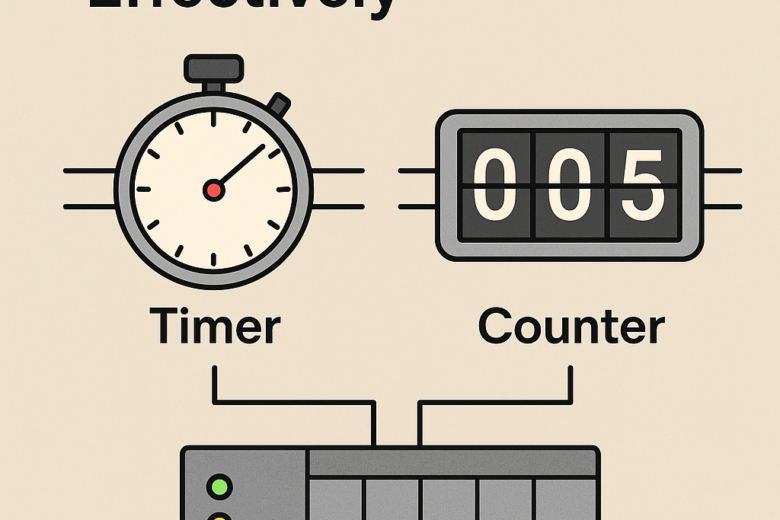Introduction:
If inputs and outputs are the arms and legs of an automation system, timers and counters are the heart and brain. Whether you’re controlling conveyors, mixing batches, or sequencing machines, timers and counters are essential for reliable, flexible, and predictable operations.
In this post, we’ll break down the types of timers and counters, real-world use cases, and tips for using them effectively in your PLC programs.
1. What Are Timers and Counters in PLCs?
Timers delay or extend actions based on time.
Counters track events — such as items passing a sensor or machine cycles completed.
They both help control processes that depend on time intervals or event counts rather than just input/output states.
2. Types of Timers
Most PLC platforms support the following timer types:
- TON (On-Delay Timer): Delays the output after the input is turned ON.
Use for: Motor start delays, valve purge times. - TOF (Off-Delay Timer): Delays the output after the input turns OFF.
Use for: Fan run-down after process stop. - TP (Pulse Timer): Generates a fixed-duration pulse.
Use for: Momentary outputs like alarms or strobes.
Example (TON in Ladder Logic):
|----[Start_Button]----[TON Timer1, 5s]----(Motor_ON)----|3. Types of Counters
- CTU (Count Up): Increases with each pulse.
Use for: Product counting, production batches. - CTD (Count Down): Decreases until zero.
Use for: Countdown to maintenance or cycles left. - CTUD (Up/Down Counter): Handles both increment and decrement.
Use for: Position tracking, balanced operations.
Example (CTU):
|----[Sensor_Pulse]----[CTU Counter1, Preset: 10]----|4. Real-World Applications
- Conveyor Line: Use a CTU to count boxes and a TON to delay the diverter.
- Batch Processing: Use TONs to hold valves open for a precise time.
- Machine Maintenance: Use CTU to count cycles and trigger alerts after a threshold.
5. Best Practices
- Reset Properly: Always include a reset condition for counters and timers.
- Use Structured Tags: Name your timers clearly, e.g.,
T_Delay_Valve,C_Bottle_Count. - Avoid Timer Overlap: Don’t nest timers unless necessary to prevent timing errors.
- Debounce Inputs: Ensure sensor bounces don’t cause multiple counts.
6. Platform-Specific Tips
- Siemens TIA Portal: Use
TON,TOF, andTPblocks withS5TIMEor IEC time. - Allen-Bradley RSLogix/Studio 5000: Use
.PRE,.ACC, and.DNbits for control. - Codesys / IEC 61131-3: Use structured functions like
TON,CTU, etc., with clear instances.
Conclusion
Timers and counters may seem basic, but they are fundamental to robust PLC programs. Mastering them means smoother sequences, better diagnostics, and smarter machines. Start simple, test thoroughly, and soon you’ll be building timing-precise, event-driven automation like a pro.
Want code examples and downloadable PLC templates? Stay tuned to PLCExpertHub.com — we’re dropping free resources soon!

